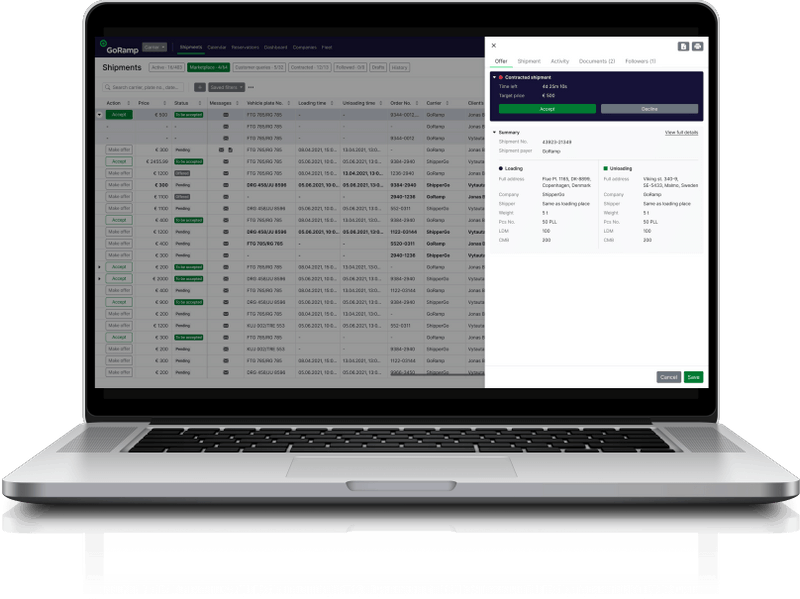Perhaps you already doing your best to manage your warehouse operations and you think your Warehouse management system works quite well. Still without a proper audit, you will never know if your warehouse performance has peaked. We have prepared a professional checklist for Supply Chain & Logistics managers based on EU and US market benchmarks. Learn more about automated dock management system and identify ways to improve your daily logistics processes.
Why do You Need a Dock Scheduling Audit for Efficient Warehouse Management?
Warehouse docks often become a critical bottleneck for manufacturing companies and distribution centres as raw materials or product shipments are constantly late. Why? Because all trucks show up at the same time, or not on their scheduled time. They are queuing while waiting for their turn to unload or pick up a shipment. At the same time, they are creating multiple delays that cascade to production lines and deliveries to customers.
.jpg)
An efficient Dock management system and well organized dock scheduling process audit can identify reasons of the bottlenecks and suggest possible improvements. Most often increasing of loading capacity, improved planning, reduced driver waiting & detention times may solve all the issues Supply Chain & Logistics managers encounter daily.
How to Conduct a Dock Scheduling Audit?
The first step is to check whether you need improvements:
Select All That Apply to Your Situation:
- Congested loading ramps and regular truck queues
- Recurring penalties for truck detention
- Poor visibility of incoming and outgoing trucks
- Peak and off-peak times at the warehouse
- Unplanned overtime for warehouse staff
If you checked at least one of the above, it is an indication that your warehouse management system should be improved and that your dock scheduling process needs attention.

What do You Currently Use for Dock Scheduling:
- Software that was developed internally
- Spreadsheets and shared calendars
- Appointment booking tools
- Whiteboards, notebooks, paper documents, etc.
- Dock scheduling platform (on-premise)
- Dock scheduling platform (SaaS)
Using spreadsheets, calendars, and appointment booking tools is like hitting the nail with the handle (of the hammer). Developing own software is incredibly expensive and paper documents should be forgotten in the age of digitalization and sustainability. Dock scheduling platform (SaaS) is the way to go - for a fixed fee you’ll have access to the latest solutions in the market.

Identify ways in which you receive information about incoming and outgoing trucks:
- Phone calls
- Emails and messages (SMS, Skype, WhatsApp, etc.)
- Shared spreadsheet or a calendar
- Dock scheduling platform
If you checked any of the first three selections, you receive information in a time consuming and slow way that is prone to human errors. In case you selected a Dock scheduling platform and any other option, you are losing part of the benefits that come from using a specialised platform. Aim to have 100% reservations done through the platform.
Identify ways in which you share confirmations, updates and delivery details with carriers, suppliers and drivers:
- Phone calls
- Emails and messages (SMS, Skype, WhatsApp, etc.)
- Automated notifications from the dock scheduling platform

Providing dock details, driving instructions and other information manually isn’t very efficient. Working with an efficient warehouse management system and automating all communication with the dock scheduling platform is the most efficient option. After the supplier books a dock, his carrier, driver, and other stakeholders get automated messages/emails with all information - dock number, date and time, driving instructions, etc.
Is it difficult to work with the dock management system?
The Dock scheduling system optimizes the delivery process as a whole and provides additional functionality for transport logistics management systems. They not only provide more convenient management, but also save direct costs. Dock management systems can increase loading and unloading performance and optimize cargo delivery management by 30%. Besides that, these systems are easy to implement and onboarding can be done in a week. More about dock scheduling software's productivity read in our blog "Our Dock Scheduling System Got Smarter".
What to do next?
Most warehousing facilities are now in the transition process - trying to move away from manual to fully automated processes. Very often, they are also not sure what is the best way to do it. If this is your situation also, let’s have a chat. Our experts will advise you on how to best set up your dock scheduling process.



